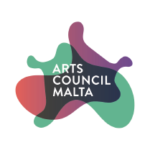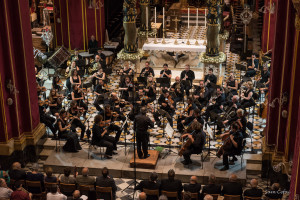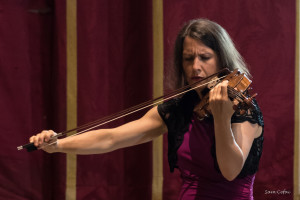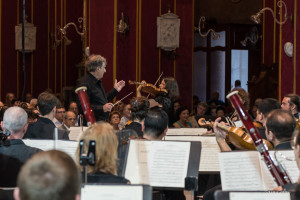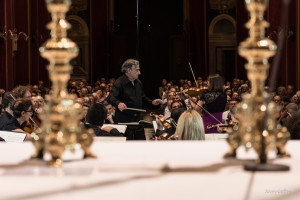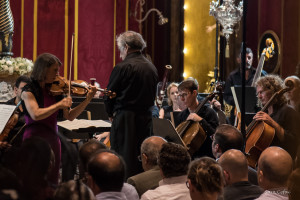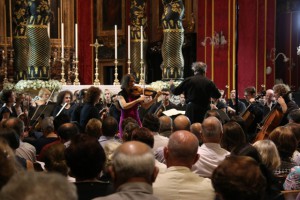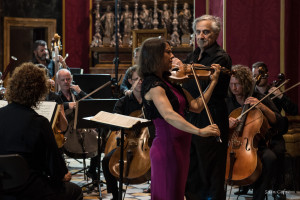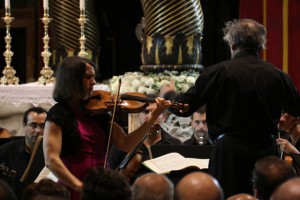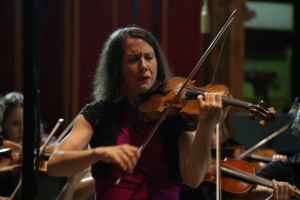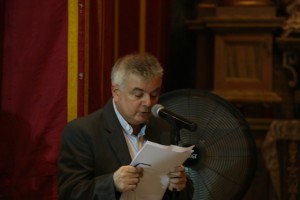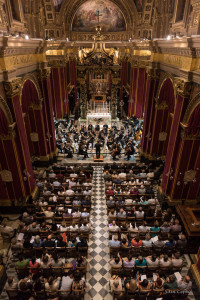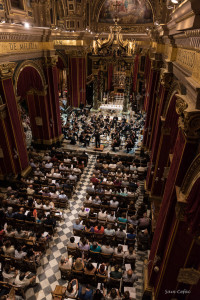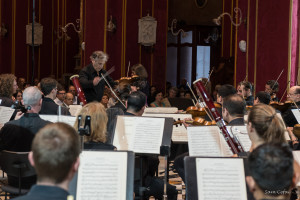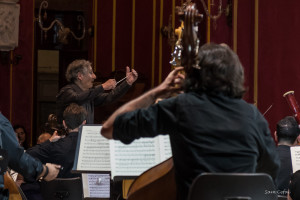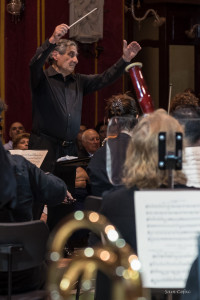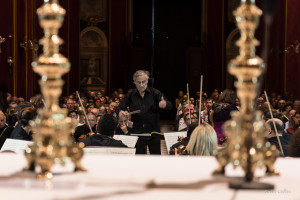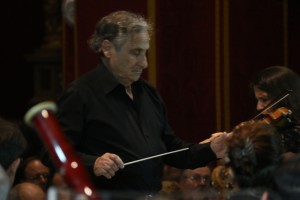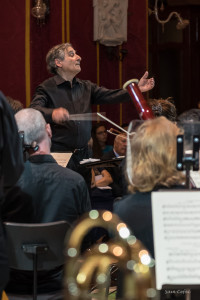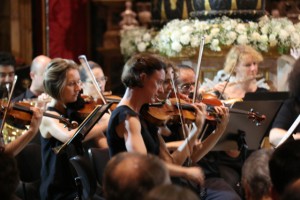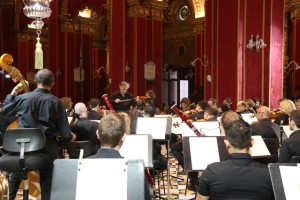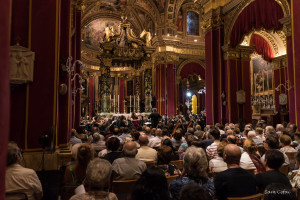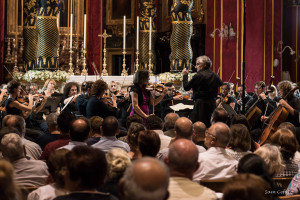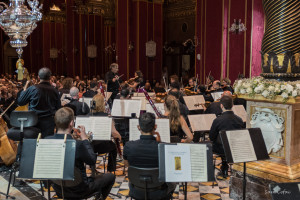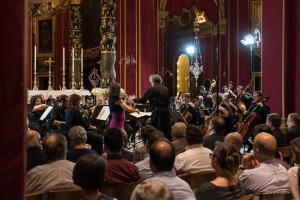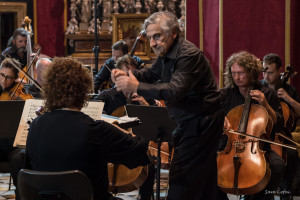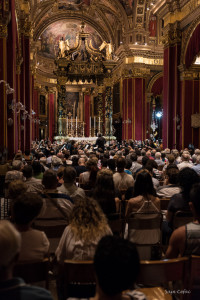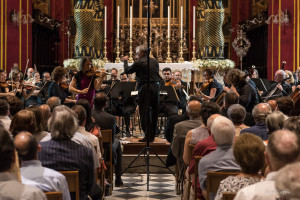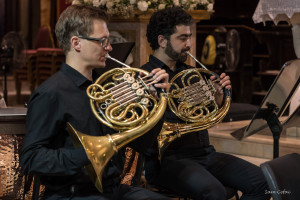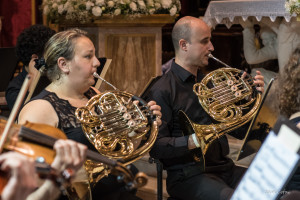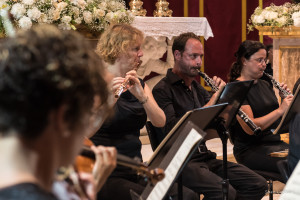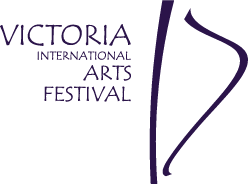Superb Ending to VIAF 2016
On Monday 11th July, VIAF 2016 came to a resounding close with a symphonic concert by the Malta Philharmonic Orchestra under the direction of VIAF Artistic Director, Joseph Vella. The concert consisted of Brahms’ Concerto in D Major for Violin and Orchestra op. 77, featuring soloist Andrea Gajic, and Tchaikovsky’s Symphony in G Minor no. 1 (‘Winter Daydreams’). It was a programme that was tackled robustly and sensitively by all concerned.
The concert was introduced by Rev. George Joseph Frendo, Assistant Artistic Director of the Victoria International Arts Festival. Performing to a packed house, and despite the searing heat, virtuoso violinist Andrea Gajic mesmerised one and all by the beauty of her tone, dazzling technique, and formidable interpretation. Projection was effortlessly achieved in the louder sections of the Brahms Concerto. This is a long work, reaching a 45 minute duration, and in both concept and structure works very much along the lines of a Symphony. One crucial difference between both genres, if one does exist, is, perhaps, that the Concerto speaks more intimately to an audience than a Symphony does. Symphonies tend to be objective structures that resist the confessional mood that a Concerto tends to impart. That said, one may argue that nothing speaks more intimately to a receptive listener than a slow movement in a symphony does, but to that later!
A Concerto is essentially a human drama, and the human element is not surprising, since the origins of the medium go back ultimately to the early forms of Renaissance vocal music. The genre turned instrumental in the Baroque period, but the idea of contrast between distinct performing forces was preserved and indeed focused more sharply than ever in terms of the individual and the group. The Classical Concerto sets the scene for this riveting opposition through the formal device known as the ‘ritornello’, which presents the basic material orchestrally at the start in more or less strict uniformity of key. It is left to the solo instrument, when its turn comes, to establish its primacy by varying and extending the orchestra’s ideas, introducing new ones of its own, and extending the music’s tonal range. When the solo instrument is a violin, the formal challenge is even more taxing than it is with a pianoforte, for instance, since the physical imbalance that has to be overcome by skill and strategy is naturally greater.
The Concerto combines two complementary aspects of the composer, that of the artist concerned with the great and serious, and that of the lyrical composer of songs. As always, Brahms was critical of his own work, and his Violin Concerto, long promised, had been the subject of his usual doubts and hesitations. In this work, Brahms creates a large structure in the Beethoven tradition. Originally four movements had been planned, but in the end the two middle movements were replaced by the present Adagio, music that Brahms described as feeble but that pleased the great if maverick Joachim (for whom the work was composed) as much as it has always pleased audiences. In fact, this slow middle movement, which is an F major Adagio, he creates a wonderful seraphic oboe solo but a stormier central section in F sharp minor before calm returns.
The Malta Philharmonic Orchestra, most ably led by Marcelline Agius, set the mood with the very first notes. There was cohesion, balance, and tonal colour aplenty – no Brahms (or Tchaikovsky) work can survive without these qualities. The opening movement, marked Allegro non troppo, had a sonorous orchestral introduction in 3/4 time amounting to a first exposition of the main theme. When the violin entered, it was with an extended display over horns in octaves and a timpani roll before playing the main theme and a secondary group, from which one melody is simply gorgeous. In fact, the actual entry of the soloist and the approach to it must remind the audience of Beethoven’s Violin Concerto, with its rather longer orchestral exposition that had so taxed the patience of Viennese audiences seventy years earlier. The absolutely dazzling cadenza that Gajic interpreted was a humbling experience, one that attested to the stunning virtuosity of this most unassuming of soloists.
Vella coaxed the most subtle and nuanced tones in the second slow movement, as indeed he then did in the simply magnificent Tchaikovsky Adagio in the Symphony that followed. This slow movement was splendidly lyrical, based on a melody of great beauty, which was expanded and developed by the soloist and the orchestra, dying away before the vigorous opening of the Hungarian-style finale. This, in rondo form, is marked Allegro giocoso ma non troppo, and is a piece of great variety, intervening episodes providing a contrast with the energetic principal theme, leading to a conclusion of mounting excitement. A rapturous applause greeted the final flourish, one that was more than merited for all performers. Gajic delighted the audience with an encore that brought the audience to its feet. One wondered where she had the extra energy to engage in yet another piece of pyrotechnical virtuosity, but engage she did, and how!
Next came the monumental Tchaikovsky Symphony no. 1 in G Minor, known as ‘Winter Daydreams’. Any Tchaikovsky work demands not only big physical forces, but profound intellectual/emotional ones as well. Once again, this work is just over 45 mins duration, and the wonderful combination of the rational and the emotional was kept in delightful equilibrium throughout. It cannot be easy to perform those gorgeous, sweeping melodies that Tchaikovsky seems to produce out of nowhere at any time and place and not be carried away in an sentimental turmoil. However, Vella’s approach to this work kept this potential disaster well at bay, and the result was a picture of eminent temperance, one that attested that the golden mean can indeed be found and kept. Climaxes were spectacular and the smaller peaks building up to these never attempted to take over the moment that really matter. In short, the wood was never missed for the trees.
To call Tchaikovsky, as some critics do, the “modern Russian Beethoven” does not give either of the composers any credit, Beethoven being patently nether modern nor Russian, and Tchaikovsky being neither Classical nor German. Before Tchaikovsky, Russia had never had a musician of stature who was more thoroughly international. The nation forms part of the external world, it is a concrete fact and, in a sense, a restriction; Tchaikovsky’s music is divorced from this external reality, it is abstract and generalised. That is why he cannot be held up as a Russian composer par excellence, in the way the ‘Big Five’ are, for instance. Artistic imagination and language are, however, the mirror of the relationship existing between the creative artist and the external world, from which it follows that Tchaikovsky’s imagination and language express a powerful individuality with abstract but brilliant accents, with pictures that are not just colourful but scintillating. This language is not pictorial as it occurs in either Rimsky-Korsakov or, even more so, in Mussorgsky, but it is intense to breaking point. It is soaring, burning and full of élan. Only occasionally, under the spell of a terrifying mood, does he find more forceful expression and more variety than either of the two composers just mentioned, but even then these moods do not assume the strength of pictures. His musical versification is hymnic, pregnant, and uniform, very much like Milton’s, one might say, if the comparison of values does not immediately invalidate the simile, I hasten to add.
Yet, Tchaikovsky is thoroughly Russian in the less tangible aspects of nationalism; in the deep poignancy of his melancholy, from which he can pass without warning into the most flighty gaudiness. It is perhaps characteristic that, although entirely under German-French influence he avoids Wagner and even Brahms, while he is strongly attracted to the classicistic Romanticists of the Mendelssohn circle and to the slightly-sentimental wing of the French school. The Russian in Tchaikovsky is not to be credited to the many Russian themes and motives used in his works. To my mind, that is not what makes him Russian. What attests to his Russianness is the indecision in his artistic character, the almost Cartesian doubt and hesitancy between mood and purpose which characterizes even his most mature works, including his Symphony in G Minor no. 1, bringing them close to the beatific vision through their intense suffering and equally intense beauty.
Tchaikovsky was extremely sensitive and self-critical, often revising well-crafted works or destroying or attempting to destroy them. Although he completed the First Symphony in August of 1866, he made a second version of it before the end of that year. Still not fully satisfied with it, he revised it once more, in 1874. The composer himself nicknamed the symphony Winter Daydreams and even gave the subtitles ‘Dreams Along a Wintry Wayside’ to the first movement and ‘Land of Desolation, Land of Mists’ to the second. As performed last Monday, marked Allegro tranquillo, the opening movement did have a dreamy quality about it, despite its generally lively manner and occasionally muscular sonority. The ensuing movement, Adagio cantabile ma non tanto, was mesmerizing in its gentleness and melodic flow, both of which invoke tranquil wintry images – no blizzards or wind here, but lots of snow outside and glowing logs in the fireplace inside. The lovely main theme, first heard on the melancholic oboe, superbly played by John McDonough, is one of the composer’s most attractive creations from his early career. There was superb playing by the strings at the start, some wonderful and evocative playing indeed! This wove a lush, warm, and beautiful carpet of sound that served as the basis on which the ensuing development emerged. And when you thought that the thematic matter had reached its resolution in came those stunning horns – spine-chilling and rousing, exploding into a magnificent climax, the embryonic form of which was first uttered by the oboe at the start, subsequently echoed by the violas and cellos and finally taken up by the strings.
In the following Scherzo – Allegro scherzando giocoso, Tchaikovsky uses material from the Scherzo of his 1865 Piano Sonata in C# Minor. In contrast to the ending of the second movement, the mood here was subdued here, but the music was upbeat, especially in the buoyant Trio. Tchaikovsky actually foreshadows the night music of Mahler near the close of this Scherzo, when the solo violoncello wittily takes up the main theme. The finale, marked Andante lugubre – Allegro maestoso, had much of the winter about its glacial pacing and barren writing in the opening. The main Allegro section brought the most vigorous and colourful texture in the Symphony. The energetic main theme is one of the composer’s most joyous creations and the orchestration throughout this movement is brilliantly realized. The first movement and the finale, as in several symphonies from the German tradition, showed thematic links, and in general the work marked an auspicious beginning for a composer who would fuse Western symphonic logic with distinctively Russian subjectivity and gloom.
Joseph Vella brought experience, maturity, intelligence, sensitivity, and flair to the reading of these scores. His is an understated style, eschewing extravagant movement and flamboyance, but one that exercises control and mastery. Balance was maintained throughout and the dynamic gradation was impressive, to say the least. There was character in abundance and the result was one of sheer enjoyment.
This was one performance that is not likely to be forgotten by those privileged to have heard it. Long may it live in our memories. It went far in establishing VIAF as one of the leading Festivals Malta can be proud of!

